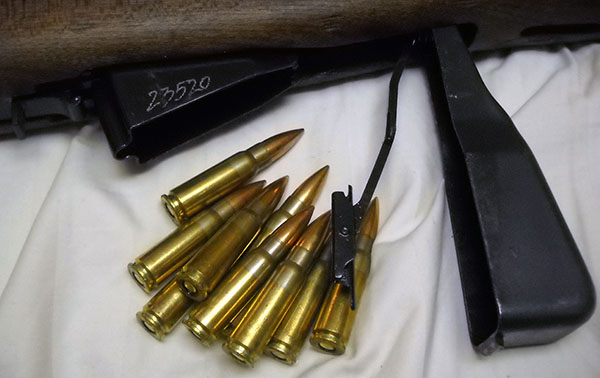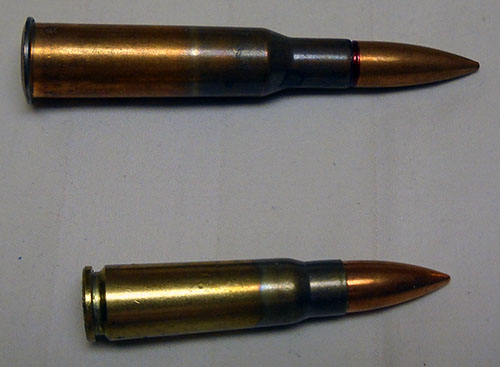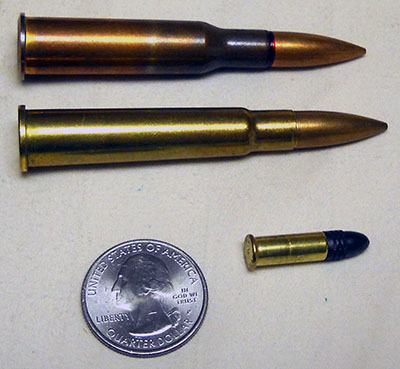LAST EDITED ON Mar-26-17 AT 05:45 PM (EDT)
I'm not going to call it a primer because that would be a pun.I was asked about doing something like this a while ago, said "Yeah, that sounds like a good idea," and then, um, didn't do it, sorry about that. Still, better late than never, right? This is some basic background information about small-arms ammunition as it it most commonly encountered nowadays. Some of it will have appeared elsewhere in these pages, other bits haven't come up so far that I can recall.
First, some very brief historical background. The self-contained cartridge as we know it today originated in the mid-1800s. "Cartridges" by that name had existed for a while by then, but the word denoted something different before about 1860. Prior to the invention of the self-contained metallic case and integral primer (the latter of which I have always assumed was a logical extension of the percussion cap), a cartridge in the firearms sense was basically a prepared packet of all the stuff you needed to load a muzzle-loading musket or rifle.¹ They were usually made of paper, and the idea was that they would be taken apart and the parts put into the gun separately. Often the paper was used as wadding between the powder charge and the bullet, so all of it got used, but the early ones were not meant to be put into the firearm as a unit.
(Later on that would sometimes change. Needle guns, for instance, were breechloaders that used paper cartridges—hadto, since the needle needed to be able to pierce the cartridge case to reach the primer inside. Those didn't stay in vogue for very long, though. Nowadays it's possible to make cap-and-ball revolver cartridges out of flash paper, so that it burns up along with the powder charge, to make reloading more convenient, but they're not necessary to make the guns function like needle guns' paper cartridges were.)
The early metallic cartridges were made from rolled brass or copper foil, which meant that they were flimsy, easily damaged, and not reusable. Not until someone worked out how to draw solid brass into a cylinder open at one end would it be really practical to make a reusable metallic cartridge case. Once someone did, though, the advantages of the system were so obvious that it quickly became The Way It's Done, and remains so to this day. Many designers have fooled around with "caseless" ammunition—back in the 1980s you would often find firearms futurists and cyberpunk roleplaying game sourcebook authors confidently predicting that the metallic cartridge would be Over by the turn of the century—but it's never really worked or offered any worthwhile advantage.
Anatomy

The photo above (showing unfired ammunition that's just been dumped out of an SKS carbine) gives a decent idea of the anatomy of a typical—not to say practically ubiquitous, these days—centerfire cartridge (7.62x39mm Soviet). There are four basic parts.
A bit paradoxically, the part of the case that's at the back when the cartridge is in its usual position in the gun is the head. Most cases have some information stamped on their heads (unsurprisingly called the headstamp); in commercial ammunition this is usually the caliber and often the brand, while military-made ammunition more commonly has random-looking code numbers not comprehensible to anyone outside the logistics and supply systems where it originated.
The cartridge we see here is called a rimless cartridge, even though it has an obvious rim. It's called that because the rim is the same diameter as or smaller than the case body ahead of it, and has an extractor groove for the firearm's extractor to grab hold of instead. We can compare this to an earlier rimmed cartridge:

Notice the obvious protruding rim on the top cartridge. This has its uses (which we'll get to in a minute), but rimmed cartridges aren't very good for use in repeating, and particularly in automatic, firearms. Anytime you have a bunch of rimmed cartridges in a vertical magazine together, they tend to get in each other's way a lot. Magazine Lee-Enfield rifles, for instance, commonly suffer from a phenomenon called rim lock, which is just what it sounds like, if their loading clips aren't arranged precisely right. In a belt-feed system, rimmed cartridges have to be pulled backward out of the belt and then sent forward into the chamber, making the loading mechanism more complicated. Repeater-wise, they only really work well in revolvers and horizontal tube magazines.
Anyway, moving on. In the center of the case head, that flat bit—best seen on the bottom-most cartridge in the SKS unloading photo—is the primer. This is the part that actually sets off the cartridge. It's made of an impact-sensitive explosive that detonates when it's struck sharply by the gun's firing pin. There's a hole in the case head underneath it, so that the spark of its detonation can go into the main body and ignite the powder charge within, setting off the cartridge.
Primers were probably the trickiest part of developing the self-contained cartridge. They have to be stable enough that they won't go off in the course of ordinary handling, and to have extended shelf lives (that they don't get unstable and tetchy toward the end of, like e.g. dynamite), and yet sensitive enough that they'll explode reliably when struck with the kind of forces available to the firing mechanisms of small arms. And those mechanisms can't be set up to hit them too hard, or they run the risk of perforating the primer entirely, which vents the combustion of the main charge back toward the firing pin. That's bad. You don't want to compromise the head of the cartridge.
Add to that, for decades after they were first developed, the chemicals used in ammunition primers were both toxic (they had fulminate of mercury in them) and corrosive (their combustion byproducts were hygroscopic, that is water-attracting, salts). This meant firearms that used them were prone to rusting in hard-to-reach places (like the bores and the inner workings of the firing mechanisms) if not scrupulously cleaned afterward. This wasn't a maintenance nightmare on par with the ungodly mess left behind by black powder, but it's still a hassle, and something to watch out for when buying elderly ex-military arms. If you buy a Mosin-Nagant or SMLE today, it has almost definitely had a lot of corrosive ammunition put through it, and you had best hope that its prior owners were all diligent about cleaning.
(Even today, if you use surplus military ammunition dating to before about 1950 for Western ammo or the early 1970s for the Soviet bloc, it's almost certainly got corrosive primers and you're going to have some cleanup to do. For that matter, a lot of brand new Russian commercial ammunition that claims it's non-corrosive on the box isn't really, at least not by Western standards. Yeah, I'm looking at you, TulAmmo, don't play innocent.)
While we're talking about rims and primers, this is a good place to mention the other common ignition system of today, rimfire ammunition, which is just what it says on the tin. Rather than having a centrally located primer, rimfire ammunition has the priming compound rolled into the cartridge rim. The firing pin mashes part of this rim against the mouth of the chamber, setting it off and causing the spark to fire sideways into the main charge.² The bottom-most cartridge in the photo below is rimfire:

(Obviously, rimfire ammunition is always rimmed.)
The advantage to rimfire ammunition is that it's cheaper and easier to mass-produce, since there's no separate primer to worry about. On the other hand, it doesn't ignite as reliably as centerfire ammunition, its empties can't be reloaded, and because it has to be rimmed, it inescapably presents all the usual problems of rimmed ammunition to feed systems.
Anyway, moving on. The next part of the cartridge is the body (sometimes also called the hull, though that's more commonly applied only to shotgun shells), which is pretty self-evident. This can be straight or tapered; many rifle and a few handgun cartridges are also bottlenecked, the derivation of which should also be pretty obvious. In a bottlenecked cartridge, the part with the steep inward slant is called the shoulder and the smaller-diameter bit after it is the neck.
Finally, out at the business end, is the bullet. In technical parlance, this term only ever refers to the actual projectile, which is why firearms pedants get so annoyed when, e.g., television reporters refer to whole cartridges as "bullets" (or, even more amusingly, empty cartridge cases as "used bullets", which I've seen more than once). Strictly speaking, a bullet is a tapered projectile of some kind; a spherical projectile is a ball if it's alone or shot if there's more than one in a single load.
Beyond that distinction, bullets come in a lot of different shapes, but only a couple are very common in civilian ammunition these days. There's the classic flat-based, round-nosed bullet, commonly found in handgun ammunition. Modern rifle ammunition usually has what's called a spitzer bullet (from the German Spitzgeschoss, "pointed projectile"), which is longer and pointier, for reasons of superior ballistics (handgun ammo is usually going slow enough that it doesn't need to worry about these things). There are also hollowpoint bullets of both basic shapes, which are designed to increase in diameter when they hit something and thus transfer their kinetic energy more effectively into the target. If you read up on this you will find all sorts of ghastly musings about "hydrostatic shock effects" and "wound channel ballistics" and we're not going to get into any of that here, except to note that ammunition advertisements have always had a certain air of breathless self-congratulation about the lethality of such things. There used to be an ad for hunting hollowpoints with the cheerful strapline, "THE DEADLIEST MUSHROOM IN THE WOODS."
Most bullets are made primarily of lead (hence any number of common figures of speech about getting shot, to be filled full of lead, to have lead poisoning, and so on), because it's easy to work with and very dense. Because lead is quite soft and melts at a fairly low temperature, modern high-velocity cartridges often apply forces and temperatures too great for plain lead bullets to withstand without leaving bits of themselves behind in the rifling (referred to as lead fouling or simply leading), which is undesirable, so it's very, very common nowdays for bullets to be partially or completely jacketed in some harder metal, usually copper. Depending on the manufacturer, jacketed bullets may be labeled "full metal jacket" (hence the title of the film), "total metal jacket", or some variation thereof. The military shorthand for FMJ ammunition, hardball, is commonly used in converstaion but usually not found on the box.
Hollowpoint rounds for handguns used to be notorious for not working very well in semiautomatics, because a lot of early semiautos were designed as military pistols, and armies almost universally use hardball (hollowpoints having been outlawed in military use by the Hague Convention of 1899).³ Hollowpoint bullets are usually not quite as long, and they're obviously not rounded at the end, so they don't play well with many semiautos' feed systems. Nowadays, more cleverly designed hollowpoints and semiauto handguns mean that there are lot of the latter that will work with at least some of the former, but it often takes a bit of hunting around to find the right match.
There are also oddball bullet types you may see the names of from time to time. Wadcutter bullets, for instance, are plain lead, cylindrical and flat on both ends; they take their name from the fact that they were assumed to make more precise holes in paper targets for competition shooting. There is also the semi-wadcutter, which is a wadcutter that tapers a bit up front, for better aerodynamics, but is still flat at the tip. Semi-wadcutters are sometimes partially jacketed on the cylindrical part, to make interacting with rifling cleaner. Some revolver shooters used to think (and a few probably still believe) that wadcutters are Especially Lethal because of their shape. This is probably not true, but you will never win an argument with anyone, ever, over whether any given cartridge or bullet type is more or less lethal than another comparable one, so never mind.
This is probably a good place to define another term you might've seen in a book or movie at some point, the so-called dum-dum bullet. This was an early form of expanding bullet, developed in 1896 for British forces in India. The idea was basically to take a half-jacketed .303 British bullet and cut a crosshatch pattern in the exposed soft-lead nose, so that it expanded more readily when it hit something (or, well, let's be realistic, someone). In the charming way in which these things were often done by the British in those days, this was customarily reserved for use against non-Christian opponents. The dum-dum gets its name from the fact that it was developed at, I kid you not, Dum Dum Arsenal (Dumdum is a town near Calcutta).
Though they were outlawed in war within three years of being invented, dum-dum bullets got into the common parlance anyhow as a shorthand for any soft-pointed or expanding round, particularly one that had been doctored specifically (and perhaps illicitly) to increase its tendency toward expansion. American organized criminals, in particular, were often accused of using them in gangland assassinations. These days it's not usually applied to ammunition that was specifically designed to be expanding, a lot of which is readily available on the civilian market for hunting and/or "defensive" purposes.
That's probably enough for one post. Next we'll talk about nomenclature.
--G.
-><-
Benjamin D. Hutchins, Co-Founder, Editor-in-Chief, & Forum Mod
Eyrie Productions, Unlimited http://www.eyrie-productions.com/
zgryphon at that email service Google has
Ceterum censeo Carthaginem esse delendam.
¹ A rifle has grooves cut into the barrel to impart a stabilizing spin to the ball or bullet; a musket is smoothbored. Although in the early days of rifling it wasn't uncommon for a muzzleloading rifle to be called a "rifled musket". But that's another show.² This, by the way, is why dry-firing a rimfire gun (i.e., actuating the firing mechanism on an empty chamber) is generally not a good idea. Because the firing pins of rimfire guns are designed to smack part of the cartridge rim into the chamber mouth, firing them without a cartridge in there can drive the firing pin directly into the chamber mouth. Over time, this will either wear down (or break outright) the firing pin, or peen a depression into the chamber mouth. The latter can lead to ignition failures, as the cartridge rim can deform into the depression rather than being crushed. In either case the gun no longer works, and if you've damaged the chamber, you've pretty much permanently ruined the whole barrel (they're usually one part).
With a centerfire system, you still may damage the firing pin (they're often designed with the assumption that they'll be decelerated by hitting a primer rather than just going straight to the end of their length of travel), but you don't stand to ruin the gun.
³ This is why the stainless steel M1911A1-type pistol prominently featured in the Hitman: Agent 47 video games is called the "Silverballer". It's based on a real-life 1911 clone called the Hardballer, formerly made by Arcadia Machine & Tool. Like virtually all 1911s, the real-life AMT Hardballer was designed to use FMJ ammunition. A tricked-out long-slide Hardballer is also featured in The Terminator, as one of the guns the T-800 steals from the pawn shop.


 Cartridges: Nomenclature
Cartridges: Nomenclature
 RE: Cartridges: Nomenclature
RE: Cartridges: Nomenclature RE: Cartridges: Nomenclature
RE: Cartridges: Nomenclature
 RE: (BG) Cartridges: An Introduction
RE: (BG) Cartridges: An Introduction RE: (BG) Cartridges: An Introduction
RE: (BG) Cartridges: An Introduction
 RE: (BG) Cartridges: An Introduction
RE: (BG) Cartridges: An Introduction RE: (BG) Cartridges: An Introduction
RE: (BG) Cartridges: An Introduction RE: (BG) Cartridges: An Introduction
RE: (BG) Cartridges: An Introduction RE: (BG) Cartridges: An Introduction
RE: (BG) Cartridges: An Introduction
 RE: (BG) Cartridges: An Introduction
RE: (BG) Cartridges: An Introduction Shooty Arcana: Headspace
Shooty Arcana: Headspace
 RE: Shooty Arcana: Headspace
RE: Shooty Arcana: Headspace
 RE: Shooty Arcana: Headspace
RE: Shooty Arcana: Headspace RE: Shooty Arcana: Headspace
RE: Shooty Arcana: Headspace
 RE: Shooty Arcana: Headspace
RE: Shooty Arcana: Headspace
 More on Cartridges: +P
More on Cartridges: +P
 Printer-friendly copy
Printer-friendly copy






